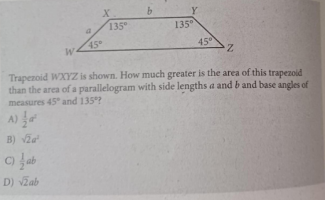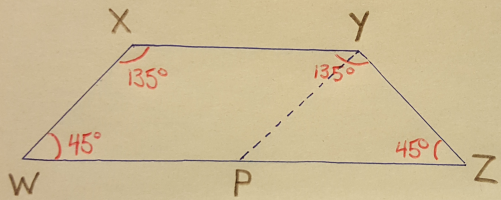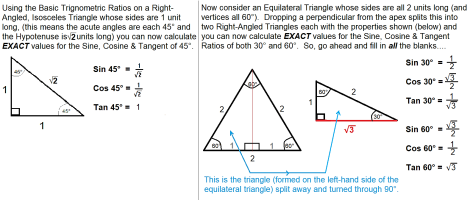Thank ou for your notes. I will look them over.
I too am confused about what you are missing. 
Perhaps if you had made a properly labelled diagram, your confusion would not have arisen? 
If you draw a line from Y to P such that the measure of ∠YPW is 135°, then |WX| = |PY| = |a| and |XY| = |WP| = |b|, so the opposite sides are equal in length in the newly created parallelogram! See diagram below...
Note too that the measure of ∠XYP is 45° (equal & opposite to ∠XWP in the parallelogram).
I have no idea how you see two parallelograms but the area of the trapezium is, clearly, greater than that of the (single) parallelogram by an area equal to that of the triangle formed at the the RHS of the parallelogram. 
No, your "final answer" is wrong!
Go through the following steps carefully and answer each question before moving on to the next step.
As mentioned above, the measure of ∠XYP is 45°, so what is the measure of ∠PYZ?
Therefore, ΔPYZ is a right-angled, isosceles triangle, isn't it?
If we drop a perpendicular from Y to Q, it will bisect ∠PYZ and create two right angles at Q (as shown below).
So what is the measure of ∠PYQ? (And ∠QYZ?)
Therefore, ΔPYQ is also a right-angled, isosceles triangle, isn't it?
I have labelled the height of ΔPYZ as h but, given the geometry here, note which other triangle sides are also h.
You are correct that the area of ΔPYZ will be: "1/2 base x height" but what are the base and the height (in terms of h)?
So what is the area of ΔPYZ in terms of h?
However, none of your "choices" involve h, do they?
But, sin 45° = ah, doesn't it?
And what is the exact value of sin 45°?
So what does h equal (in terms of a)?
And what can you now say the area of ΔPYZ is?
And, therefore, what is the correct "choice" from the options provided?
Please now come back and show us your (improved) diagram and working (laid out as above) with the correct answers at each stage, finishing off with what you now believe to be the correct choice. Thank you.
Hope that helps. 
Hello Teacher Highlander!
Here are my thoughts now.
I get the two parallelograms this way: the question mentions a parallelogram with base angles of 45 and 135 and sides of a and b. Although there's no figure given for it (I drew it on my own scratch paper), that's the first parallelogram.
The second parallelogram is the one I created when I drew a line in the given trapezoid. I created a triangle on the right and a parallelogram on the left. The 2nd (new) parallelogram has the same angle measurements as the one described in the question.
In the parallelogram embedded in the trapezoid, <WXY is 135 degrees, which means < WPY is 135 degrees. < XWZ is still 45 degrees, and < XYP is 45 degrees. (In figure below.) Because < XYP is 45 degrees, the triangle <PYZ has an angle of 90 degrees (135 - 45 = 90). < YZP is 45 degrees, and so < YPZ also has to be 45 degrees since there are only 180 degrees in a triangle.
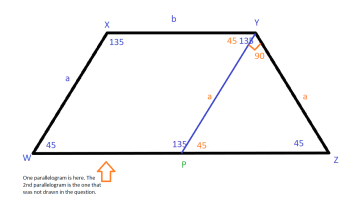
To find the difference in size between the trapezoid and the parallelogram, I need the area of the triangle. I see the silly mistake I made before as b is not the base of the triangle.
Since the opposite sides of a parallelogram are equal, line YP must also be a. Since the angle in the triangle across from YP (length of a) is 45 degrees, and the angle across from YZ is also 45 degrees, that makes YZ the same length as YP.
By dropping an altitude from < PYZ to the base, I get this figure below:
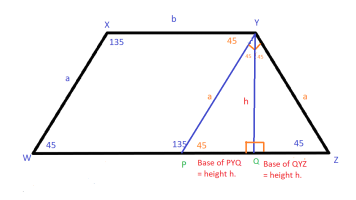
I see I have two 45-45-90 triangles because the height cuts the 90-degree angle in two. The ratio of sides of a 45-45-90 triangle is x:x:xrt2. Since the hypotenuse is length a, the base and height of each triangle is a/rt2:
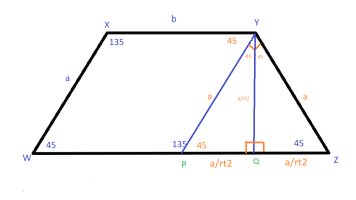
Your explanation included finding information using sine. I understand that sin 45 = opp/hyp or h/a, so h = a/rt2, so sin 45 = a/rt2 divided by a. Simplifying, I get
a 1 1
--- x ---- = ----
rt2 a rt2
Given my gaps in trigonometry, I am not clear on how finding the sine is necessary to move this problem forward. Is there a reason you suggest using sine rather than using the 45-45-90 ratios directly?
In all events, I see I have two 45-45-90 triangles. The hypotenuse of each is a, and given the ratios, the bases and heights of each is a/rt2.
To get the area of one triangle, I use the 1/2 base x height formula, and I get:
1 a a 1 a^2
-- x --- x --- = -- x ----
2 rt2 rt2 2 2
Since I have two triangles, I have to double that result to get the area of the whole triangle. The answer is a^2 / 2 or choice A.
Maybe I am missing something here, but could I also forget about dropping the altitude and using special right triangles if I notice early on that I have a right triangle with equal sides?
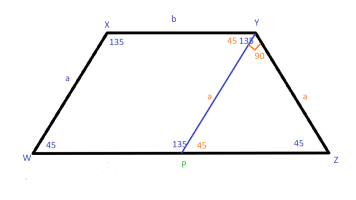
YP and YZ can be the base and height, and I can just plug those a's into the 1/2 base x height formula.
1 a^2
-- a x a = --------
2 2
Thanks again for your help. I very much appreciate the time you took on this.
Regards,
Sophia.
